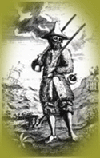|
|
|
|
|
|
|
|
|
|
|
|
|
|
|
|
|
|
|
|
|
|
|
|
|
|
|
|
|
 |
|
|
 |
|
 |
|
|
|
|
|
|
|
|
|
CONTENTS
HOME
ABOUT
THIS SITE
TOWARDS
DIGITAL STORYTELLING FOR CHILDREN
THE
EVOLUTION OF STORYTELLING FROM THE MIDDLE AGES
1990'S:
A DIGITAL ENVIRONMENT
TOWARDS
DIGITAL STORYTELLING
BIBLIOGRAPHY
Links
Links will be provided for
key words and ideas in the essay. They are marked with an asterisk in the text
but can only be accessed from the link column.
Robinson Crusoe
Chapbooks
A Little Pretty Pocket
Book
|
|
|
|
|
|
|
|
|
|
|
|
|
|
|
|
|
|
|
|
|
|
|
|
|
|
|
|
1700's:
Introduction to Adventure
|
|
|
|
|
|
|
|
|
|
|
|
|
|
|
|
|
|
|
|
|
|
|
|
|
 |
|
|
Locke's
philosophy reflected how the attitudes about children and therefore
children's literature were slowly changing. In France, the writer Perrault compiled
a group of fairytales which had entertained the children of Parisian aristocrats
for generations and these were translated into the English as Tales of Mother
Goose. Shortly afterwards, two adventure stories, Robinson Crusoe* and Gulliver's
Travels, introduced a new genre. These were adult books but they quickly became
very popular with children who, no doubt, found them a novelty amidst all the
instructional and religious materials which existed for them. |
|
|
|
|
|
|
|
|
|
|
|
|
|
|
|
|
|
|
|
|
Because
of its popularity the adventure formula of these stories was soon copied
and copycat adventures were soon being printed in large quantities in the form
of chapbooks. Chapbooks* were poorly printed, but they were attractive, small,
could be sold for pennies, and were in great demand by a public hungry for popular
stories--the precursors of our pocketbooks. Itinerant peddlers, the first "corner
cigar stores," sold them along with other wares such as ribbons and patent medicines.
Printers fed the demanding public with books of ballad tales, romantic legends,
religious inst - uction, interpretations of the supernatural, and historic narratives,
not many of them lasting in quality. Chapbooks, or "penny dreadfuls," were very
popular until the early 1800's and are a good example of how books had become
a commodity. Entrepreneurs had seen a market eager for narrative and were prepared
to fill it with whatever they could find, good or not (Demers & Moyles 78). (This
was a portent of how narrative was to be affected by the tremendous demand for
it in the 1900's.) |
|
|
|
|
|
|
|
|
|
|
|
|
|
|
|
|
|
|
|
|
|
 |
|
|
|
|
|
|
|
|
|
|
|
|
|
|
|
|
|
|
|
|
|
|
|
|
|
|
|
|
|
|
|
|
|
|
|
|
|
|
|
|
|
|
John
Newbery, a writer and publisher of the mid-1700's, advocated a milder
approach to the education of children and felt that they should be led in their
search for knowledge. In 1744 he started publishing books for children which were
intended as diversions, intended to both instruct and entertain. His books had
gilt-paper covers, attractive pages, and engaging stories. The following advertisement
appears on June 18, 1744, in the London Penny Advisor and heralds the era of children's
literature: |
|
|
|
|
|
|
|
|
|
|
|
|
|
|
|
|
|
|
|
|
|
|
|
|
|
|
|
 |
|
|
|
|
|
|
|
|
|
|
|
|
A LITTLE PRETTY POCKET
BOOK, intended for the Instruction and Amusement of little Master Tommy and
pretty Miss Polly; with an agreeable Letter to each from Jack the Giant-Killer,
as also a Ball and Pin cushion, the Use of which will infallibly make Tommy
a good Boy and Polly a good Girl. (Norton 51)
(This type of
marketing is so similar to what we see in Barnes and Nobles today that it is
almost uncanny. Newbery was heralding a new philosophical approach to children's
literature, are today's publishers?)
|
|
|
|
|
|
|
|
|
|
|
|
|
|
|
|
|
|
|
|
|
|
|
|
|
|
|
|
|
|
|
|
|
|
|
|
|
|
|
|
|
|
|
|
While
Locke felt children should be led in their search for knowledge,
Jean Jacques Rousseau (1712-1778) believed children should merely be accompanied.
His ideas are exemplified by the statement, "Man was born free, and everywhere
he is in chains". They were so radical that his Social Contract and Emile were
burned in the public squares of Geneva and Paris, his books were banned from
publication, and he himself was banished. Nevertheless, the ideas persisted
and influenced children's writers over the next hundred years to write purposeful
and carefully designed narratives which would "cultivate rational thought and
moral judgement" (Demers & Moyles 121). These stories endeavored to make learning
active, engaging and self-directed. (A similar approach to learning is strongly
supported in the 1990's.)
|
|
|
|
|
|
|
|
|
|
|
|
|
|
|
 |
 |
 |
 |
 |
 |
 |
 |
 |
 |
 |
 |
 |
 |
 |
 |
 |
 |
 |
 |
 |
 |





